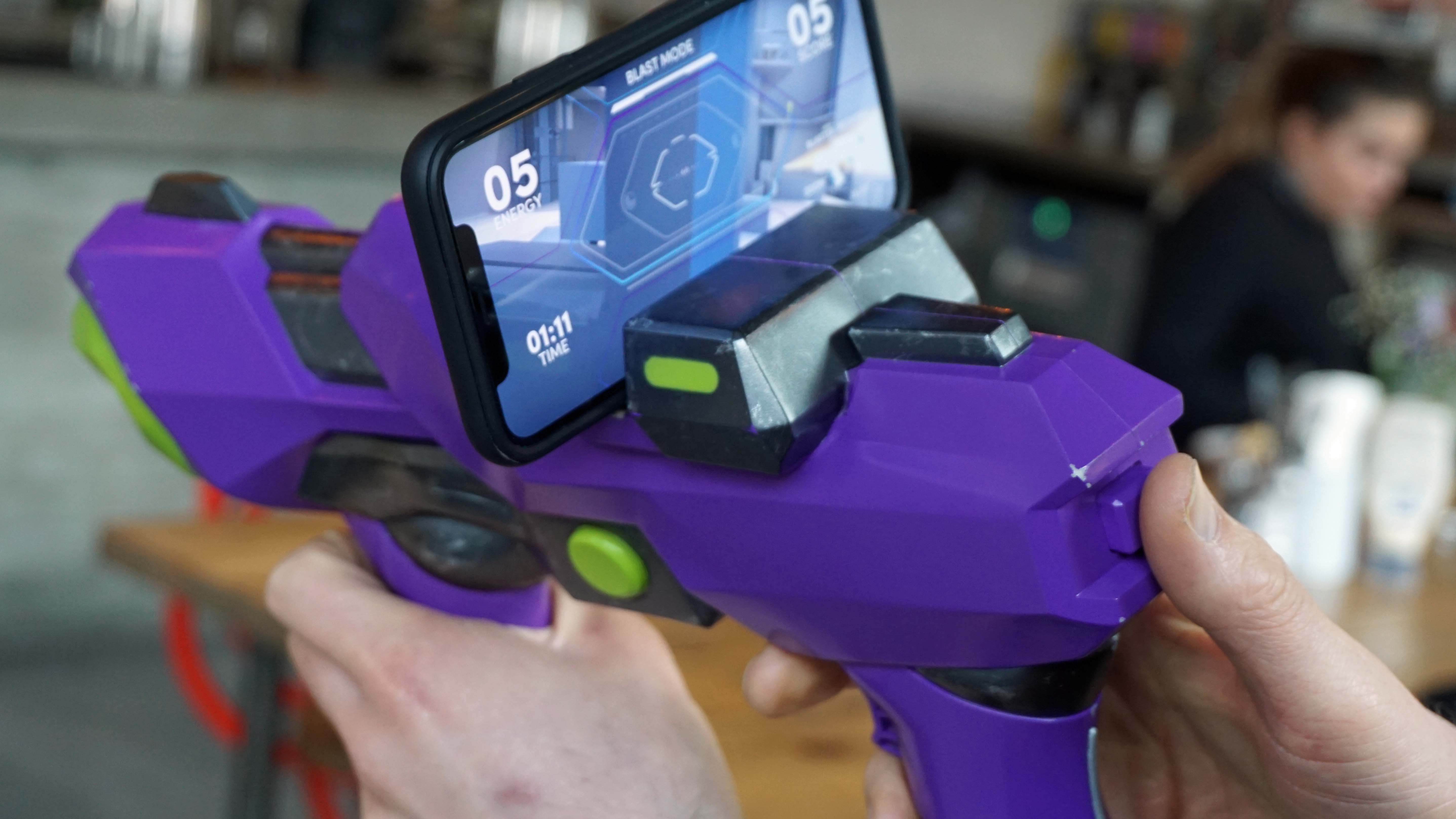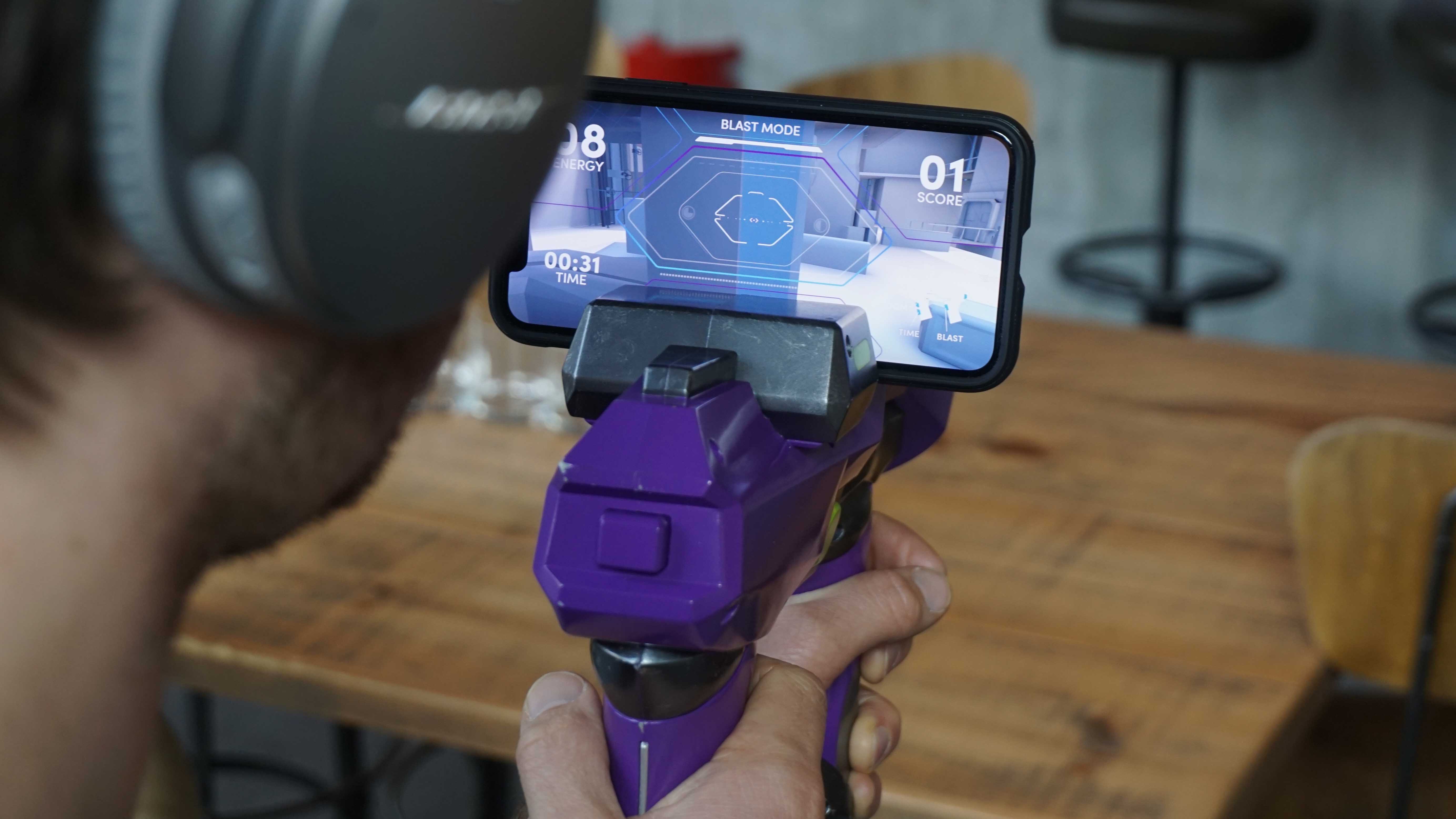Early Verdict
Merge has done it again, creating a fun and unique product that merges VR and AR technology with a whole lot of fun.
Pros
- +
Easy to use
- +
Nice AR/VR mix
- +
So much fun
Cons
- -
Form factor limits the type of game
- -
Very plasticky
- -
Not many games... yet
Why you can trust TechRadar
No matter how immersive a VR game is, there is still the big problem of the goggles.
Yes, they are improving and yes they are getting smaller but there is no getting away from the fact that you have to strap something close to your eyes for the illusion to work.
Merge has gotten round this with its latest 'AR/VR' toy - the Merge Blaster. You may remember the company for its Merge Cube, which was released last year. It was an AR accessory that was unique and allowed you to hold the world of augmented reality in the palm of your hand.
Design and build
At first glance, the Merge Blaster isn’t as original. It’s essentially a plastic gun but one that still utilizes a phone to offer all the smarts of a VR/AR game - instead of playing through goggles, you watch your phone screen on the top.
No goggles means you can duck around the room you are in, move left and right to dodge being fired at without fear that you will smash into something - all the while playing an immersive game. That’s the theory, anyway.

TechRadar recently locked and loaded with the Merge Blaster and it is a huge amount of fun. The gun itself is oversized, colorful and, well, Nerf like.
It’s a big plastic accessory that doesn’t actually have a great deal to it. And that’s the beauty of the thing: it’s a rather low-cost peripheral that leaves the grunt to your smartphone and the apps.

Merge are calling its device the 6DoF Blaster. This slightly clunky name refers to the ‘six degrees of freedom tracking’ technology that is built into the device. This is the same type of tracking that is found in more expensive VR units, such as the HTC Vive (and also the basis for the Sixaxis PlayStation controller).
It’s the idea that you have freedom of movement in a 3D space, so you can look left, right, up, down - pretty much wherever you want within the game.
The beauty of the Merge Blaster is that you don’t have to use Bluetooth or, well, anything to connect the phone up to the device. Simply slot it into the top of the blaster, make sure the app is running and away you go.

How it works is pretty simple but effective. There are a number of physical buttons that align the with the bottom part of the phone screen and when you pull any of these triggers, these buttons correspond this with what is going on in the game.
Performance
We were shown a demo of a blaster game set on a spaceship and played through this a number of times. What surprised us was how shallow the learning curve was for the game - it was practically a straight line.
There we were, toy gun in hand, watching the screen and following the instructions. Shoot this person (easy) dodge this laser (a little tougher) shoot more than one person (still easy but very fun). You go through a short instructional section then you are let loose. And that’s when we started to do strange things.

We began to hide behind real objects that were in the way of the fake ones on the screen. We moved forward a bit, swinging our arms around to another unsuspecting villain and shot them with laser beams. All the while we were zoned in on the phone screen.
Early verdict
The folks at Merge definitely have something with the Merge Blaster. The unit we played with was definitely pre-production but the form factor will be similar when it eventually is released. Price hasn’t been locked down yet but Merge is looking to be competitive within the market it’s now competing in, and that’s among the Nerfs of the world.
The only other issue is a lack of games. Merge is remedying this by opening the Merge 6DoF Blaster SDK up to its developer network. That hopefully means when the device is launched later in the year there should be plenty of games which will turn your living room into a real-life battleground.
Marc Chacksfield is the Editor In Chief, Shortlist.com at DC Thomson. He started out life as a movie writer for numerous (now defunct) magazines and soon found himself online - editing a gaggle of gadget sites, including TechRadar, Digital Camera World and Tom's Guide UK. At Shortlist you'll find him mostly writing about movies and tech, so no change there then.
What is a hands on review?
Hands on reviews' are a journalist's first impressions of a piece of kit based on spending some time with it. It may be just a few moments, or a few hours. The important thing is we have been able to play with it ourselves and can give you some sense of what it's like to use, even if it's only an embryonic view. For more information, see TechRadar's Reviews Guarantee.

